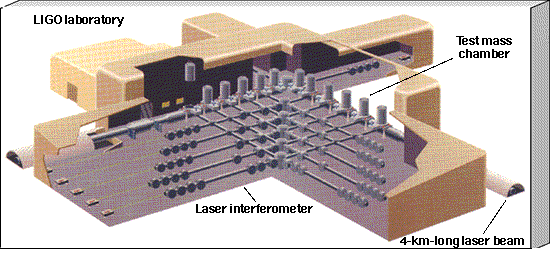| Electromagnetic waves are common, everyday phenomena. Whether they are radio, infrared, visible, ultraviolet, X-ray, or gamma-ray radiation, all electromagnetic waves involve periodic changes in the strengths of electric and magnetic fields. The modern theory of gravity—Einstein's theory of relativity (see More Precisely 22-1)—also predicts waves that move through space. A gravity wave is the gravitational counterpart of an electromagnetic wave. Gravitational radiation results from changes in the strength of a gravitational field. In principle, any time an object of any mass accelerates, a gravity wave should be emitted at the speed of light. The passage of a gravity wave should produce small distortions in the space through which it passes. Gravity is an exceedingly weak force compared with electromagnetism, so these distortions are expected to be very small—in fact, much smaller than the diameter of an atomic nucleus for the waves that may be produced by any sources located in the Milky Way galaxy—yet many researchers believe that these distortions should be measurable. So far, though, no one has succeeded in detecting gravity waves. However, their detection would provide very strong support for the theory of relativity, so scientists are eager to search for them. Theorists are still debating which kinds of astronomical objects should produce gravity waves detectable on Earth. Leading candidates include (1) the merger of a binary-star system, (2) the collapse of a star into a black hole, and (3) the collision of two black holes or of two neutron stars. Because each of these possibilities involves the acceleration of huge masses, the strength of the gravitational fields should change drastically and rapidly in each case. Other astronomical objects are also expected to emit gravity waves, but only changes involving large masses will produce waves intense enough to be observed. Of the three candidates, the first one probably presents the best chance for detecting gravity waves, at least for the present. Binary-star systems should emit gravitational radiation as the component stars orbit each other. As energy escapes in the form of gravity waves the two stars slowly spiral toward each other, orbiting more rapidly and |
emitting even more gravitational radiation. This runaway situation can lead to the decay and eventual merger of close binary systems in a relatively short time (which, in this case, means tens or hundreds of millions of years). As we saw in the text (Section 22.3), these mergers may be the cause of gamma-ray bursts, so gravitational radiation may provide an alternative means of studying these violent and mysterious phenomena.
Such a slow but steady decay in the orbit of a binary system has in fact been detected. In 1974 radio astronomer Joseph Taylor and his student Russell Hulse at the University of Massachusetts discovered a very unusual binary system. Both components are neutron stars, and one is observable from Earth as a pulsar. This system has become known as the binary pulsar. Measurements of the periodic Doppler shift of the pulsar's radiation prove that its orbit is slowly shrinking. Furthermore, the rate at which the orbit is shrinking is exactly what would be predicted by relativity theory if the energy were being carried off by gravity waves. Even though the gravity waves themselves have not yet been detected, the binary pulsar is regarded by most astronomers as a very strong piece of evidence in favor of general relativity. Taylor and Hulse received the 1993 Nobel Prize in physics for their discovery. Gravity waves should contain a great deal of information about the physical events in some of the most exotic regions of space. In 1992, funding was approved for an ambitious gravity-wave observatory called LIGO—short for Laser Interferometric Gravity-wave Observatory. Twin detectors, one in the state of Washington, the other in Louisiana, will use laser beams to measure the extremely small distortions of space produced by gravitational radiation. The accompanying figure shows the complex arrangement of test masses, hanging from wires and fitted with mirrors, that lies at the heart of the LIGO detector. The laser beams will be used to measure the tiny motions of these masses that will result should a gravity wave pass by. They should be capable of detecting gravity waves from many Galactic and extragalactic sources. Work began on building the detectors in 1995; they should be operational by 2000. If successful, the discovery of gravity waves could herald a new age in astronomy, in much the same way that invisible electromagnetic waves, unknown a century ago, revolutionized classical astronomy and led to the field of modern astrophysics. |
 |
|